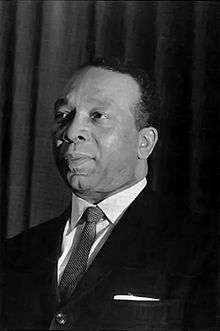Democratic Party presidential primaries, 1976
| | |||||||||||||||||||||||||||||||||||||||||||||||||||||||||||||||||||
| |||||||||||||||||||||||||||||||||||||||||||||||||||||||||||||||||||
| |||||||||||||||||||||||||||||||||||||||||||||||||||||||||||||||||||
|
| |||||||||||||||||||||||||||||||||||||||||||||||||||||||||||||||||||
| |||||||||||||||||||||||||||||||||||||||||||||||||||||||||||||||||||
The 1976 Democratic presidential primaries were the selection process by which voters of the Democratic Party chose its nominee for President of the United States in the 1976 U.S. presidential election. Former Georgia Governor Jimmy Carter was selected as the nominee through a series of primary elections and caucuses culminating in the 1976 Democratic National Convention held from July 12 to July 15, 1976, in New York City.
Primary race
The Watergate scandal, resignation of Richard Nixon, American withdrawal from Vietnam, and recession of 1974-75 dominated domestic issues in the runup to the presidential election of 76. President Gerald Ford had squandered his early popularity with an unconditional pardon of Nixon and his perceived mishandling of the recession, and by late 1975 had slumped badly in national polls.
Due to the absence of any clear front-runner for the nomination and a political climate that seemed tilted heavily in their party's favor, a record number of Democrats competed for their party's presidential nomination in 1976. However, most of these candidates would drop out early in the race.
The 1976 campaign featured a record number of state primaries and caucuses, and it was the first presidential campaign in which the primary system was dominant. However, most of the Democratic candidates failed to realize the significance of the increased number of primaries, or the importance of creating momentum by winning the early contests. The one candidate who did see the opportunities in the new nominating system was Jimmy Carter, a former state senator and Governor of Georgia. Carter, who was virtually unknown at the national level, would never have gotten the Democratic nomination under the old, boss-dominated nominating system, but given the public disgust with political corruption following Richard Nixon's resignation, Carter realized that his obscurity and "fresh face" could be an asset in the primaries. Carter's plan was to run in all of the primaries and caucuses, beginning with the Iowa caucus, and build up momentum by winning "somewhere" each time primary elections were held. Carter startled many political experts by finishing second in the Iowa caucuses (where he came in second to "uncommitted"). Arizona Congressman Morris Udall, who had been leading in the polls at one point, came in fifth behind Fred R. Harris, leading Harris to coin the term "winnowed in", referring to his surprisingly strong showing.[1][2][3][4] Carter then won the New Hampshire primary on February 24, thus proving that a Southerner could win in the North. He then proceeded to slowly but steadily accumulate delegates in primaries around the nation. He also knocked his key rivals out of the race one by one. He defeated George Wallace in the North Carolina primary March 23, thus eliminating his main rival in the South. He defeated Senator Henry "Scoop" Jackson in Pennsylvania April 27, and Jackson quit the race. In the Wisconsin primary on April 6, Carter scored an impressive come-from-behind victory over Mo Udall, and eliminated Udall as a serious contender.
As Carter closed in on the nomination, an "ABC" (Anybody But Carter) movement started among Northern and Western liberal Democrats who worried that Carter's Southern upbringing would make him too conservative for the Democratic Party. The leaders of the ABC movement - Idaho Senator Frank Church and California Governor Jerry Brown - announced their candidacies for the Democratic nomination and defeated Carter in several late primaries. However, their campaigns started too late to prevent Carter from gathering the remaining delegates he needed to capture the nomination.
Nominee
-

Former Governor Jimmy Carter of Georgia
Withdrew after names had been put in nomination
-

Representative Morris Udall of Arizona
Withdrew during primaries
-

Senator Birch Bayh of Indiana
-

Senator Lloyd Bentsen of Texas
-

Senator Robert Byrd of West Virginia
-

Senator Frank Church of Idaho
-

Delegate Walter Fauntroy of Washington, D.C.
-

Former Senator Fred Harris of Oklahoma
-
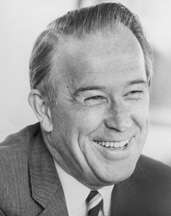
Senator Henry M. Jackson of Washington
-

Former Ambassador to France Sargent Shriver of Maryland
Withdrew before primaries
-

Former Governor Terry Sanford of North Carolina
-

Senator Walter Mondale of Minnesota
Primaries
Scoop Jackson raised his national profile by speaking out on Soviet-U.S. relations and Middle East policy regularly, and was considered a front-runner for the nomination when he announced the start of his campaign in February 1975. Jackson received substantial financial support from Jewish-Americans who admired his pro-Israel views, but Jackson's support of the Vietnam War resulted in hostility from the left wing of the Democratic Party.
Jackson chose to run on social issues, emphasizing law and order and his opposition to busing. Jackson was also hoping for support from labor, but the possibility that Hubert Humphrey might enter the race caused unions to offer only lukewarm support.[5][6][7][8]
Jackson made the fateful decision not to compete in the early Iowa caucus and New Hampshire primary, which Carter won after liberals split their votes among four other candidates. Though Jackson won the Massachusetts and New York primaries, he dropped out on May 1 after losing the critical Pennsylvania primary to Carter by 12 points and running out of money.[5][6][7][8]
Statewide contest by winner
Results by state:[9]
| Jimmy Carter | Jerry Brown | George Wallace | Mo Udall | Scoop Jackson | Frank Church | Lloyd Bentsen | Robert Byrd | Sargent Shriver | Fred Harris | Ellen McCormack | Milton Shapp | Birch Bayh | Uncommitted | ||
|---|---|---|---|---|---|---|---|---|---|---|---|---|---|---|---|
| January 19 | Iowa | 27.57% | - | - | 5.99% | 1.10% | - | - | - | 3.30% | 9.89% | - | - | 13.19% | 37.16% |
| February 24 | New Hampshire | 28.37% | - | 1.29% | 22.71% | 2.25% | - | - | - | 8.19% | 10.76% | 1.22% | - | 15.19% | - |
| March 2 | Massachusetts | 13.85% | - | 16.73% | 17.73% | 22.34% | - | 0.05% | - | 7.24% | 7.57% | 3.50% | 2.95% | 4.75% | 1.33% |
| March 2 | Vermont | 42.19% | - | - | - | - | - | - | - | 27.64% | 12.64% | 8.59% | - | - | - |
| March 9 | Florida | 34.52% | - | 30.52% | 2.09% | 23.91% | 0.38% | - | 0.39% | 0.55% | 0.42% | 0.58% | 2.48% | 0.67% | 2.89% |
| March 16 | Illinois | 48.09% | - | 27.58% | - | - | - | - | - | 16.31% | 7.54% | - | - | - | - |
| March 23 | North Carolina | 53.64% | - | 34.75% | 2.32% | 4.26% | - | 0.28% | - | - | 0.98% | - | - | - | 3.78% |
| April 6 | Wisconsin | 36.63% | - | 12.49% | 35.62% | 6.43% | - | - | - | - | 1.11% | 3.64% | - | - | 0.97% |
| April 27 | Pennsylvania | 36.95% | - | 11.25% | 18.71% | 24.57% | - | - | - | - | 0.94% | 2.80% | 2.38% | 1.11% | - |
| May 1 | Texas | 47.65% | - | 17.53% | - | - | - | 22.20% | - | 1.85% | 2.03% | 0.37% | - | - | 8.38% |
| May 4 | Georgia | 83.44% | - | 11.46% | 1.94% | 0.67% | 0.49% | 0.06% | 0.72% | 0.27% | 0.14% | 0.13% | 0.04% | 0.16% | - |
| May 4 | Indiana | 67.95% | - | 15.16% | - | 11.73% | - | - | - | - | - | 5.16% | - | - | - |
| May 4 | Washington, D.C. | 31.60% | - | - | 21.02% | - | - | - | - | - | 1.39% | - | - | - | - |
| May 11 | Connecticut | 33.16% | - | - | 30.86% | 17.75% | - | - | - | - | - | - | - | - | 12.90% |
| May 11 | Nebraska | 37.62% | - | 3.18% | 2.68% | 1.51% | 38.45% | - | - | 0.22% | 0.46% | 3.45% | - | 0.23% | - |
| May 11 | West Virginia | - | - | 10.99% | - | - | - | - | 89.01% | - | - | - | - | - | - |
| May 18 | Maryland | 37.08% | 48.45% | 4.09% | 5.54% | 2.36% | - | - | - | - | 1.16% | 1.34% | - | - | - |
| May 18 | Michigan | 43.40% | - | 6.94% | 43.06% | 1.46% | - | - | - | 0.81% | 0.58% | 1.08% | - | - | 2.24% |
| May 25 | Arkansas | 62.63% | - | 16.54% | 7.53% | 1.90% | - | - | - | - | - | - | - | - | 11.39% |
| May 25 | Idaho | 11.85% | 1.95% | 1.50% | 1.32% | 0.65% | 78.72% | - | - | - | 0.43% | - | - | - | 1.30% |
| May 25 | Kentucky | 59.38% | - | 16.84% | 10.87% | 2.68% | - | - | - | - | - | 5.58% | - | - | 3.91% |
| May 25 | Nevada | 23.35% | 52.73% | 3.31% | 2.97% | 2.52% | 9.01% | - | - | - | - | - | - | - | 6.12% |
| May 25 | Oregon | 26.65% | 24.69% | 1.34% | 2.72% | 1.23% | 33.61% | - | - | - | 0.31% | 0.87% | - | 0.17% | - |
| May 25 | Tennessee | 77.60% | 0.47% | 10.92% | 3.72% | 1.70% | 2.40% | - | - | - | 0.49% | 0.53% | 0.15% | - | 1.84% |
| June 1 | Arizona Caucus | 10.39% | - | 6.97% | 71.39% | 5.50% | 1.60% | - | - | - | - | 1.20% | - | - | 2.95% |
| June 1 | Montana | 24.64% | - | 3.44% | 6.28% | 2.67% | 59.39% | - | - | - | - | - | - | - | 3.58% |
| June 1 | Rhode Island | 30.22% | - | 0.84% | 4.21% | 1.25% | 27.21% | - | - | - | - | 4.09% | 0.22% | 0.41% | 31.54% |
| June 1 | South Dakota | 41.22% | - | 2.41% | 33.25% | 0.95% | - | - | - | - | 0.98% | 7.77% | - | - | 13.42% |
| June 1 | Washington Caucus | - | - | - | 6.22% | 78.60% | - | - | - | - | - | - | - | - | 12.25% |
| June 8 | California | 20.44% | 59.04% | 3.00% | 5.03% | 1.13% | 7.35% | - | - | - | 0.50% | 0.86% | - | 0.34% | 2.31% |
| June 8 | New Jersey | 58.38% | - | 8.64% | - | 8.82% | 13.59% | - | - | - | - | 6.03% | - | - | - |
| June 8 | Ohio | 52.29% | - | 5.64% | 21.19% | 3.12% | 13.92% | - | - | - | - | - | - | - | - |
| Legend: | 1st place (popular vote) |
2nd place (popular vote) |
3rd place (popular vote) |
Candidate has withdrawn |
Candidate had not yet Joined |
|---|
Total popular vote
Total popular vote in primaries[10]
- Jimmy Carter - 6,971,770 (40.16%)
- Jerry Brown - 2,449,374 (13.98%)
- George Wallace - 2,236,186 (12.75%)
- Mo Udall - 1,611,754 (9.16%)
- Henry M. Jackson - 1,134,375 (6.32%)
- Frank Church - 830,818 (4.77%)
- Unpledged - 412,915 (2.37%)
- Lloyd Bentsen - 347,078 (1.99%)
- Robert Byrd - 340,309 (1.95%)
- Sargent Shriver - 332,919 (1.91%)
- Fred R. Harris - 265,947 (1.52%)
- Ellen McCormack - 243,727 (1.40%)
- Milton Shapp - 88,254 (0.50%)
- Birch Bayh - 86,438 (0.49%)
- Hubert Humphrey - 61,992 (0.35%)
- Others - 32,380 (0.18%)
- Ted Kennedy - 19,805 (0.12%)
- Walter Fauntroy - 10,149 (0.05%)
- Walter Washington - 5,161 (0.03%)
- Terry Sanford - 404 (0.00%)
Democratic National Convention
The 1976 Democratic National Convention was held in New York City. By the time the convention opened Carter already had more than enough delegates to win the nomination, and so the major emphasis at the convention was to create an appearance of party unity, which had been lacking in the 1968 and 1972 Democratic Conventions. Carter easily won the nomination on the first ballot; he then chose Senator Walter Mondale of Minnesota, a liberal and a protege of Hubert Humphrey, as his running mate.
The tally at the convention was:[11]
- Jimmy Carter - 2,239 (74.48%)
- Mo Udall - 330 (10.98%)
- Jerry Brown - 301 (10.01%)
- George Wallace - 57 (1.90%)
- Ellen McCormack - 22 (0.73%)
- Frank Church - 19 (0.63%)
- Hubert Humphrey - 10 (0.33%)
- Henry M. Jackson - 10 (0.33%)
- Fred R. Harris - 9 (0.30%)
- Milton Shapp - 2 (0.07%)
- Robert Byrd, Cesar Chavez, Leon Jaworski, Barbara Jordan, Ted Kennedy, Jennings Randolph, Fred Stover - each 1 vote (0.03%)
Vice-Presidential nomination
-
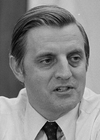
Senator Walter F. Mondale of Minnesota
-

Senator Edmund S. Muskie of Maine
-

Senator Frank Church of Idaho
-
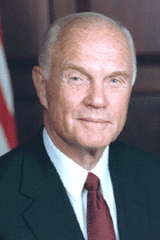
Senator John Glenn of Ohio
-
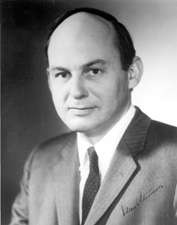
Senator Adlai Stevenson III of Illinois
-

Senator Henry M. Jackson of Washington
-
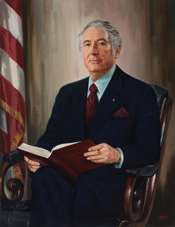
Congressman Peter W. Rodino of New Jersey
-
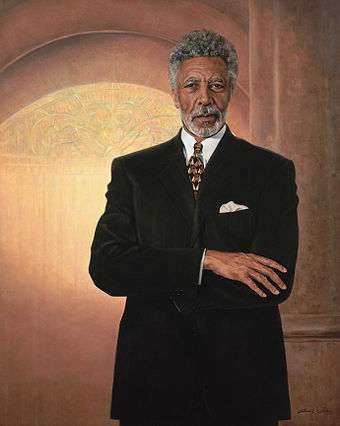
Congressman Ron Dellums of California
-
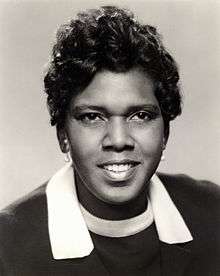
Congresswoman Barbara Jordan of Texas
By June, Carter had the nomination sufficiently locked up and could take time to interview potential vice-presidential candidates.
The pundits predicted that Frank Church would be tapped to provide balance as an experienced senator with strong liberal credentials. Church promoted himself, persuading friends to intervene with Carter in his behalf. If a quick choice had been required as in past conventions, Carter later recalled, he would probably have chosen Church. But the longer period for deliberation gave Carter time to worry about his compatibility with the publicity-seeking Church, who had a tendency to be long-winded. Instead, Carter invited Senators Edmund Muskie, John Glenn, Walter Mondale, and Congressmen Peter W. Rodino to visit his home in Plains, Georgia, for personal interviews, while Church, Henry M. Jackson, and Adlai Stevenson III would be interviewed at the convention in New York. Rodino revealed he had no interest in the position, and of all the other potential candidates, Carter found Mondale the most compatible. As a result, Carter selected Mondale as his running mate.
African American leadership within the Democratic Party had sought to potentially place Los Angeles Mayor Tom Bradley, Congressmen Ron Dellums, or Congresswoman Barbara Jordan on the ticket with Carter. However, Jordan took herself out of consideration, and Carter did not have any interest in the other candidates put forward.
The vice presidential tally, in part, was:
- Walter Mondale 2837
- House Speaker Carl Albert 36
- Ronald Dellums 20
- Fritz Efaw 12
- Barbara Jordan 17
- Others 53
See also
References
- ↑ Jules Witcover, No Way to Pick A President: How Money and Hired Guns Have Debased American Elections, 2001, p.166
- ↑ George C. Edwards, John Howard Kessel, Bert A. Rockman, Researching the presidency: vital questions, new approaches, 1993, p.60
- ↑ http://www.thegreenpapers.com/PCom/?20040129-0
- ↑ http://www.thegreenpapers.com/PCom/?20080201-0
- 1 2 Oldham, Kit (August 19, 2003). "Jackson, Henry M. "Scoop"". HistoryLink.org.
- 1 2 David Wilma and Kit Oldham (November 7, 2003). "State voters elect Dixy Lee Ray as first woman governor of Washington, re-elect Senator Henry Jackson and House incumbents, and prefer Ford to Carter on November 2, 1976.". HistoryLink.org.
- 1 2 Salam, Reihan (May 27, 2003). "Double Scoop". The New Republic Online.
- 1 2 "Jimmy Carter's Big Breakthrough". Time Magazine. May 10, 1976.
- ↑ Elections
- ↑ Our Campaigns - US President - D Primaries Race - Feb 01, 1976
- ↑ Our Campaigns - US President - D Convention Race - Jul 12, 1976





.png)
